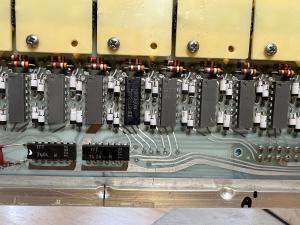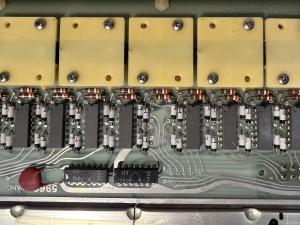Wang 600 Wire ROM Repair
Next Log Entry
Major Success, Minor Disappointment
SP380 Sense Latch IC Replacement Options
The SP380 is an unusual IC from Signetics’ “Utilogic” family, a DTL-TTL hybrid technology introduced by Signetics in 1964 and finally displaced in the early 1970s by the 7400 TTL family. One curious feature of the entire family is that Pin 1 is always GND and the diagonal (pin 8) is Vcc, this rotation and mirroring from the 74xx conventions can be disconcerting and confusing when probing a PCB that has these ICs and 74xx TTL ICs.
It is not clear why the SP380 was used in the ROM sense circuit in preference to 7400 series quad NORs such as the 7402. Notably, the SP380 inputs connect to transistor bases and not to transistor emitters as in 7400 series TTL. This may be significant in the operation of the ROM sense circuit. This, together with the atypical pin layout, suggested that effort should be made to obtain exact replacements rather than attempt to use a 7402 or similar more readily available TTL part.
Searching vintage databooks and NOS parts suppliers revealed the Signetics 8T380, a quad-NOR with function, package and pinout the same as the SP380 and stated by Signetics to be a “better-performing” drop-in replacement for the SP380. The main differences appear to be lower input current, higher noise immunity and better-defined input hysteresis. Some of these features seemed likely to be helpful in the ROM sense circuit but the altered input current was a concern, lest this upset the characteristics of the sense transformer output. Surprisingly, the vintage data books did not show the input circuit of the 8T380 so it was not possible assess if there may be relevant differences. 8T380s were available from NOS suppliers and the best option appeared to be to take Signetics’ word that the 8T380 was a direct replacement for the SP380.
Replacement of Faulty SP380
Removal and replacement of the SP380 is somewhat challenging because it is adjacent to the ROM transformer area and there is some risk of damage to the data wires. However, the ROM has been dumped and it is of very little use while one bit is missing from each location. Therefore, the potential benefit of restoring the missing bit outweighs the risk of causing further damage.
Wang fibreglass PCBs have been found to be vulnerable to heat damage, softening, shedding traces and easily charring under component removal heating. Fortunately the SP380 could be removed and replaced with only minor trace damage.
Success: KK bit restored
Reading the ROM showed that the KK1 was now active, with the KK field having a full complement of 4-bit values. All fields now have complete 1-, 3- or 4-bit values, indicating that all column sense circuits have basic function.
AI BI ZO AOP AC BC MOP KK ST JC JADH JADM JADL JH JL
0 1282 1257 580 1464 1292 1739 1372 906 1533 1848 804 198 174 928 945
1 27 674 62 258 756 308 72 117 26 200 1244 108 111 842 690
2 26 4 127 64 0 0 128 97 7 0 0 138 119 65 77
3 208 7 448 70 0 0 127 86 62 0 0 100 101 82 77
4 101 47 205 32 0 0 79 61 69 0 0 103 135 1 180
5 61 23 138 52 0 0 82 53 5 0 0 106 126 124 1
6 336 3 486 107 0 0 146 68 5 0 0 102 144 5 17
7 7 2 0 0 0 0 4 46 40 0 0 96 122 1 61
8 0 0 0 0 0 0 3 81 37 0 0 142 117 0 0
9 0 0 0 0 0 0 0 67 7 0 0 177 123 0 0
A 0 0 0 0 0 0 7 51 19 0 0 189 128 0 0
B 0 0 0 0 0 0 1 40 29 0 0 152 156 0 0
C 0 0 0 0 0 0 3 65 24 0 0 121 139 0 0
D 0 0 0 0 0 0 3 116 120 0 0 104 138 0 0
E 0 0 0 0 0 0 2 151 2 0 0 106 103 0 0
F 0 0 0 0 0 0 16 43 60 0 0 98 106 0 0
This is a very good result. Before this repair the data dumped from the ROM was of very little use because every location was missing one bit. After this repair 2044 addresses have complete data, so potentially 99.8% of the CC2001 ROM image can be recovered. There are still four silent addresses that may be repairable but even if not, these may be amenable to reconstruction by software reverse engineering.
Note that later analysis showed significant errors in the above data due to unstable read errors. See a later post for complete and accurate ROM frequency analysis
Assessment of Open-Circuit ROM Wire Repairs
Knowing the physical location of the four open data wires on the ROM board it’s worth considering if replacement wires could be grafted and threaded through the data transformers.
Grafting Replacement Wires
There is reasonable access to the outputs of the row current drivers and attaching new wire(s) to the drivers should not be a major problem.
Gaining safe access to the relevant column select diode anodes is unfortunately quite another thing. The diode field is overlaid by hundreds of data wires and while ther overlay is sparse in some places it is very dense in others. Grafting a new wire requires getting a soldering iron through the overlaid wires and onto the relevant diode. Doing this through the sparse overlay would be risky, while the dense overlay looks to pose an extreme risk of damaging more wires than one is seeking to replace. Unfortunately, three of the failed wires arise in areas of very dense overlay.
Sient Addresses Not Repairable
It seems that the CC2001 ROM board is better not repaired further as there is a very high chance of making matters worse.
Fortunately, the ROM emulator has been successful and restoration of machine CC2001 can proceed with the wire ROM in situ for original appearance and the emulator furnishing
- a repaired CC2001 ROM image, or
- a ROM image from another machine
The emulator allows both of these options to be available, or for that matter for entirely new microcode to be used.
The CC2001 Wire ROM will be re-installed for appearance but the machine will run on emulated ROM.
Previous Log Entry Back to Log Index Next Log Entry


